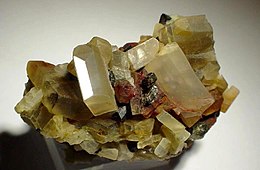
Back أوليغوكلاس Arabic Oligoclasa Catalan Oligoklas Czech Oligoklas German Oligoklazo Esperanto Oligoclasa Spanish Oligoklass Estonian اولیگوکلاز Persian Oligoclase French Oligoclasio Galician
| Oligoclase | |
|---|---|
 Oligoclase from Chihuahua, Mexico | |
| General | |
| Category | plagioclase, feldspar, tectosilicate |
| Formula (repeating unit) | (Ca,Na)(Al,Si)4O8, where Ca/(Ca + Na) (% anorthite) is between 10–30% |
| Crystal system | Triclinic |
| Crystal class | Pinacoidal (1) (same H-M symbol) |
| Identification | |
| Color | Usually white, with shades of grey, green, or red[1] |
| Cleavage | Perfect {001}, Good {010}, Poor {110}. |
| Fracture | Uneven, sub-conchoidal |
| Mohs scale hardness | 6 to 6.5 |
| Luster | Vitreous |
| Streak | White |
| Specific gravity | 2.64 to 2.66 |
| Refractive index | nα = 1.533–1.543; nβ = 1.537–1.548; nγ = 1.542–1.552 |
| Birefringence | 1st order |
Oligoclase is a rock-forming mineral belonging to the plagioclase feldspars. In chemical composition and in its crystallographic and physical characters it is intermediate between albite (NaAlSi3O8) and anorthite (CaAl2Si2O8).[1] The albite:anorthite molar ratio of oligoclase ranges from 90:10 to 70:30.
Oligoclase is a high sodium feldspar crystallizing in the triclinic system. The Mohs hardness is 6 to 6.5 and the specific gravity is 2.64 to 2.66. The refractive indices are: nα = 1.533–1.543, nβ = 1.537–1.548, and nγ = 1.542–1.552. In color it is usually white, with shades of grey, green, or red.[1]
Oligoclase is a common mineral in the more silica-rich varieties of igneous rock and in many metamorphic rocks.
- ^ a b c One or more of the preceding sentences incorporates text from a publication now in the public domain: Spencer, Leonard James (1911). "Oligoclase". In Chisholm, Hugh (ed.). Encyclopædia Britannica. Vol. 20 (11th ed.). Cambridge University Press. p. 82.